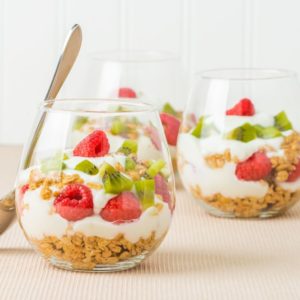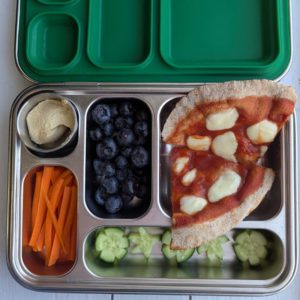
Planning and cooking a nutritionally balanced meal can seem futile if you have picky eaters. Check out our solutions to the most common “food fights.”
You spend over half an hour planning and cooking a nutritionally balanced meal, and you hope the meal will be a big success. Then, all your efforts seem futile when your toddler refuses to eat. Solving the problem of your child’s “food fights” begins with answering these seven questions.
Does your child have a hard time transitioning from play time to meal time?
- Problem: Difficult Transitions. You interpret it as a refusal of that particular food and are tempted to offer a “favorite” food.
- Solution: A few minutes before the meal is ready, let your child know they have a few more minutes until it’s time to eat. For toddlers, facilitate the switch of focus from play to food by using a transition-object, such as the bib, bowl, spoon, or plate: “Do you want to wear your red bib or your blue bib for dinner tonight?” Preschoolers can be directly involved: “Can you help mommy put the napkins on the table?”
Did your child have sufficient physical activity before dinner?
- Problem: Your child can’t sit in the chair and wants to run around the room. You chase your toddler with the spoon. The end result: you prevent your child from developing a healthy relationship with food and deny the child’s ability to follow cues for hunger and satiety.
- Solution: Part of the problem may be an excess of energy that needs to be expended before dinner. Plan the day to allow for plenty of physical activity. Children need 60 minutes of aerobic activity a day. Make it a habit to go on a walk or playground before cooking dinner. Ditch the stroller and have a “funny walks contest” for half an hour when both you and your toddler skip, jump, run, and have fun. Be realistic: most toddlers won’t sit for more than 15 minutes and preschoolers for more than 20.
Did your child have a large, satiating snack not long before dinnertime?
- Problem: Your child is snacking, too late or too much. The afternoon snack needs to be well-timed, well-balanced, and portion-sized for your child’s age.
- Solution: Offer a well-timed snack, 2 hours earlier than dinner time. Make sure the snack is balanced, with at least two food groups. See the article Two Simple Steps to Nutritious and Delicious Snacks. Check out these articles for great snack ideas specific for toddlers: Grab-n-go Snacks for Toddlers and Saving the Snack Emergency.
Did your toddler have a nap during the day?
- Problem: Your child is too tired to eat and too exhausted to tune into their body’s hunger cues. As tempting as it may be to allow your high-energy toddler to skip a nap, in hopes of an earlier bedtime, remember that many temper-tantrums can be avoided by keeping a happy toddler on schedule.
- Solution: Well-timed naps and snacks can help improve meal times. Toddlers thrive on schedules and need a structured-world. Create a schedule with routines.
Is your child’s internal clock out of sync with your schedule?
- Problem: You and your child have different biorhythms. Your child may not be hungry at the time when dinner is usually served. Or worse: your child may be hungry at different times and rarely at the same time of day.
- Solution: Do not feed your child separately from family meals. Eating meals together as a family has a positive impact on your child’s learning and understanding of healthy eating habits. Try giving an earlier snack, and limit the amount of snack and milk given close to mealtimes. Sometimes kids are too hungry to wait for the family meal. Try offering a healthy appetizer of fruit or vegetables to hold them over. If possible, experiment with slight variations of dinner time. Remember: toddlers need consistency and predictability. They are happy when things happen in the same way and at similar times. Capitalize on rituals: when the toddler sees mommy put on the apron, it’s a cue for dinner.
Does your toddler drink too much liquid?
- Problem: Your child is drinking too much. Unrestricted access to liquids can result in diminished appetite. Filling up on excessive milk or juice displaces other nutritious foods from the diet.
- Solution: If you choose to offer juice, limit juice to 4 oz per day for toddlers; you can offer juice as-is or diluted it with water. Between feedings, respond to thirst by offering water. When planning meals, factor in liquids. Offer milk with each meal: for the 3 main meals offer half a cup (4 oz.) of milk with each meal. Toddlers need 2 cups of milk (16 oz) a day, according to the current USDA MyPlate guidelines for ages 2-5 years; dairy foods can be factored in to meet this requirement (2).
- Example: 3 meals x ½ cup milk per meal = 12 oz total, leaving you another 4 oz milk, which can be offered as either ½ cup yogurt for snack OR 1 oz cheese in a whole-wheat quesadilla for lunch OR ½ cup of milk.
Does your child have strong preferences for very few foods?
- Problem: Your child refuses to eat any new foods and has an exclusive preference for a few foods, also referred to as “being a typical toddler.” The obvious danger is that you will always offer them the accepted foods and avoid presenting any new foods.
- Solution: Don’t give up! Keep exploring what appeals to your toddler. Remind your child that it is okay to dislike a new food, but encourage them to at least taste it. Consider it progress if the food touches the inside of his or her mouth! Have a cup of water handy and be patient. Keep offering the foods to your child’s in small amounts.
- Bonus Tip: Use “favorite foods” as a “facilitator” for introducing new foods, by creating multi-ingredient dishes. If the favorite is tomatoes, offer it in various ways: raw slices, pasta with chunky tomato sauce, quinoa with tomato sauce, tomato soup, etc. You can also try different shapes, i.e. cut it into round slices on one day and lengthwise on another day. This will help keep your toddler open to variety. A useful read on this topic is Challenged by a Finicky Eater in Your House?
Now that you’re a pro at problem-solving your child’s “food fights,” let’s review:
Key points to remember:
- Rituals: Give structure, stability, and predictability to your toddler’s world
- Transitions: Facilitate the switch of focus from playtime to mealtime
- Snacks: Need to be well-timed, well-balanced, and well portioned
Test Your Knowledge
1. What are two key elements parents of toddlers should capitalize on?
- Rituals and transitions
- Rigid schedules and authoritativeness
- Very flexible schedules and responding to the toddler’s mood
- Confronting the toddler and setting limits
Answer A
2. How should snacks be timed in a toddler’s day?
- Only offer snacks if the toddler asks for one, to avoid “stuffing” the toddler
- Snacks can be used as a meal-replacement, depending on how the day progresses
- Don’t give toddlers any snacks, so they will develop a good appetite for main meals
- Well-timed snacks, ideally three a day, and snack no later than 2 hours before dinner
Answer D
3. What is the relation between sleep and meals in the schedule of toddlers?
- No relation, they are completely separate issue
- When toddlers are sleep deprived, they overeat and have binge-eating episodes
- When toddlers skip a nap, their internal biological clock is upset, which can cause a decrease in appetite
- It’s best to allow toddlers to skip naps, to ensure that they will sleep well at night
Answer C












